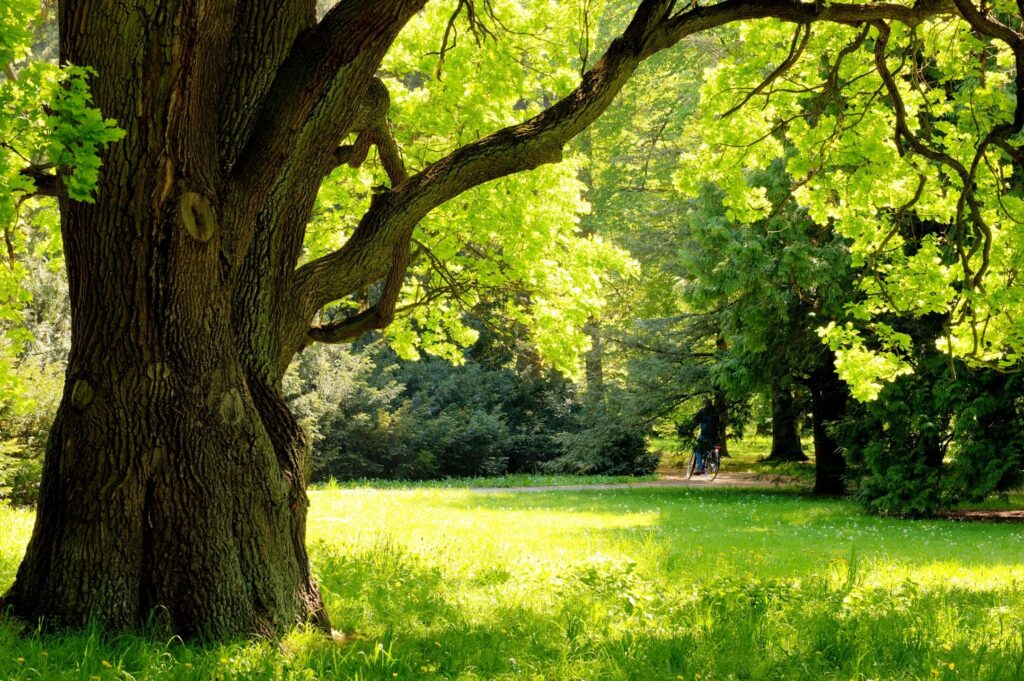
After 50 years of gardening and lots of research, I’ve developed a list so I can plant the right trees. Trees are the biggest investment decision for the long-term enjoyment of our outdoor spaces. I’m now located in Southwest Ontario Zone 6a, however, these selections would be great for any regions rated as Canadian zones 5b-7a which is roughly equivalent to US zones 5a-6b. Difference between Canadian and US zones.
By the way, spring or fall are excellent times to plant trees! (see more about planting at the end of this article).
Given the longevity of trees, and their value to our properties, taking the time to choose wisely is well worth the effort!
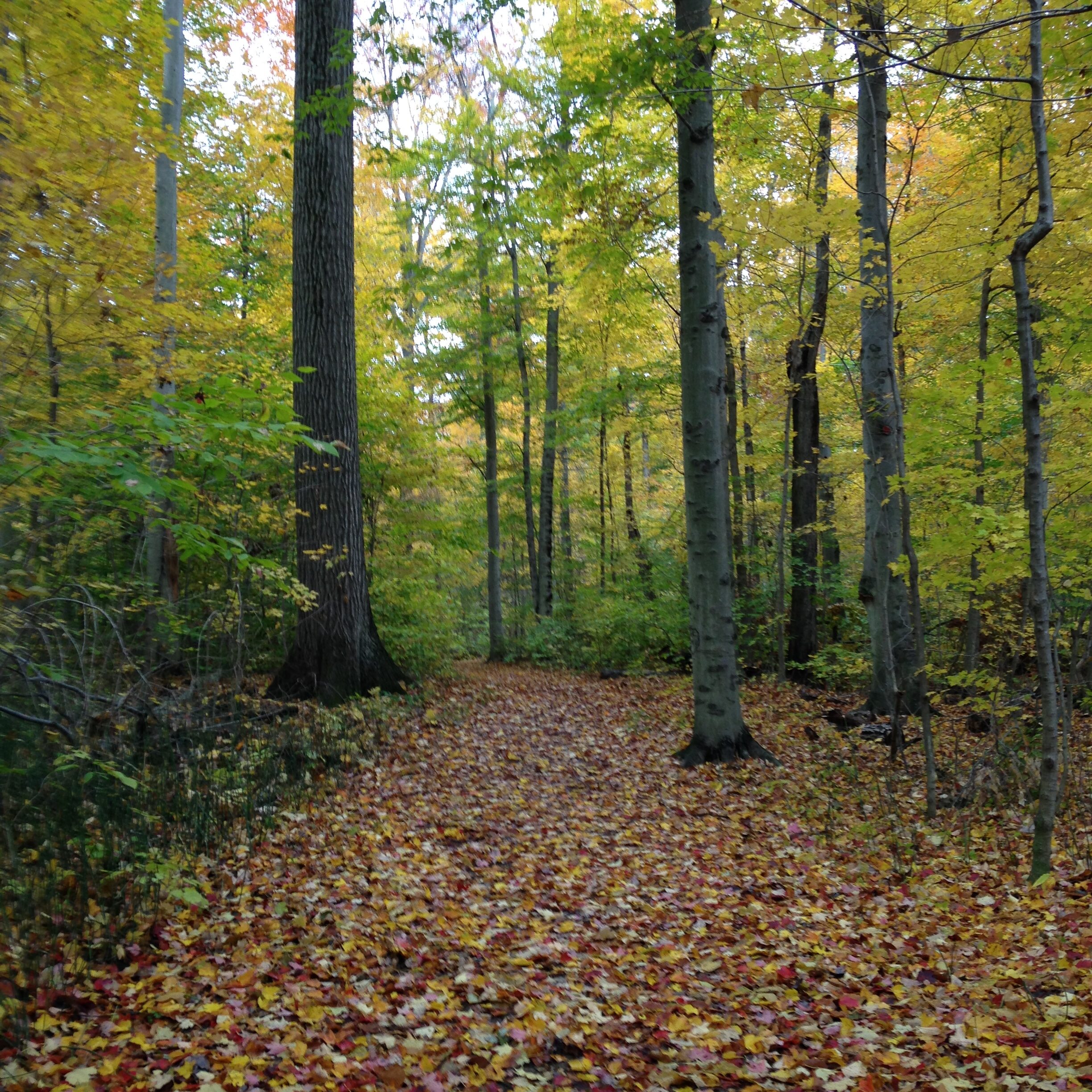
A Quick Recap – Benefits of Trees.
- Shade – reduce interior temps by 5°C when sited properly. US EPA studies report that shaded surfaces may be 20–45°F (11–25°C) cooler than the peak temperatures of unshaded materials.1 Evapotranspiration, alone or in combination with shading, can help reduce peak summer temperatures by 2–9°F (1–5°C)
- Protect from wind/heat/sun with screens, sheltered area for family activities and entertaining, overhead shade
- Aesthetics – more curb appeal and beautiful to look at
- Climate-Smart – trees absorb, or ‘sequester’, carbon dioxide (CO2) from the atmosphere through the process of photosynthesis. Using water and sunlight, trees convert CO2 into sugars which are used to help the tree grow. The remaining oxygen is then released back into the atmosphere
- Resale value – proven to be one of the best investments! The secret is to plant hardy trees, that are disease-resistant and well-suited to the site

To plant the right trees, think long-term
Top 10 Considerations to Plant the Right Trees
* Climate-change factors
1. Know your Zone – plant only what’s hardy for your area. Find the zone for your Canadian municipality.
2.*Choose healthy species – Consider trees that are not struggling with widespread disease or pests, often made worse by the changing climate. Ontario tree diseases and pests Tip – Avoid ash, and elm and be cautious about blue spruce. I’m concerned about the threat of oak wilt and beech bark diseases too but they are still good choices for now. My List – The Worse Threats to Southwest Ontario trees
3.*Choose species more likely to survive our changing weather including local native varieties and those that are doing well despite changeable weather. If Southern Ontario choices don’t appeal to you, select a species thriving ‘One-Zone South’ in the northeastern United States. As our climate changes, you’ll be assisting with species migration.
4.*Beware of large trees on urban lots – Trees are susceptible to lightning, wind, hail, ice, and snow. Avoid planting trees on small urban lots that will become taller than 30 ft at maturity. These don’t play well with other plantings, and also become a threat to homes in our increasingly extreme winds and violent weather. Choose from varieties with a mature spread of no more than 6 m (20 ft) and a height of 6-9 m (20-30 ft).
5.*Choose Diversity vs Monoculture – avoid planting too much of any single variety. A monoculture is not eco-friendly and your investment will be highly susceptible to the next pest or disease. Think of all the ash trees we’ve recently lost! Avoid Monoculture Landscape Choices
6. Keep canopy in mind – some smaller trees will not do well if exposed to full sun and wind as they are adapted to growing within a forest canopy. Plant a layered canopy if possible.
7.*Location matters – plant evergreens (needle-bearing trees) on the north and west side of your home to block increasingly strong winter winds and deciduous varieties on the south side to offer shade in as our summers get hotter and more humid. Don’t forget water management. We now get more deluges, and lack of drainage can drown a young tree. And then we see weeks of drought, so plan to water new trees weekly for approximately two years after planting.
8. Plant properly – once you’ve invested in the right choice, ensure it goes in the ground with the best possible chance to thrive. See planting and care tips below.
9. Pollution and Salt issues – have you seen rows of brown shrubs along the front of properties? Or rows of burlap-covered shrubs that take a lot of work to wrap each fall and spring? If your site is near a street or highway, research specific varieties that will tolerate road salt!
10. Choose what suits your site. We can choose what we want, but site conditions really matter as to whether it will thrive. Assess your site conditions:
- site exposure to sun and winter wind
- soil – clay, loam, sand?
- lot size, amount of canopy room you actually have
- nearby buildings, paths, ponds, or other existing features
- overhead wires
- amount of moisture – a wet area or bone dry? Access to water tap?
- how your tree’s branches, seeds, and leaves will impact neighbours
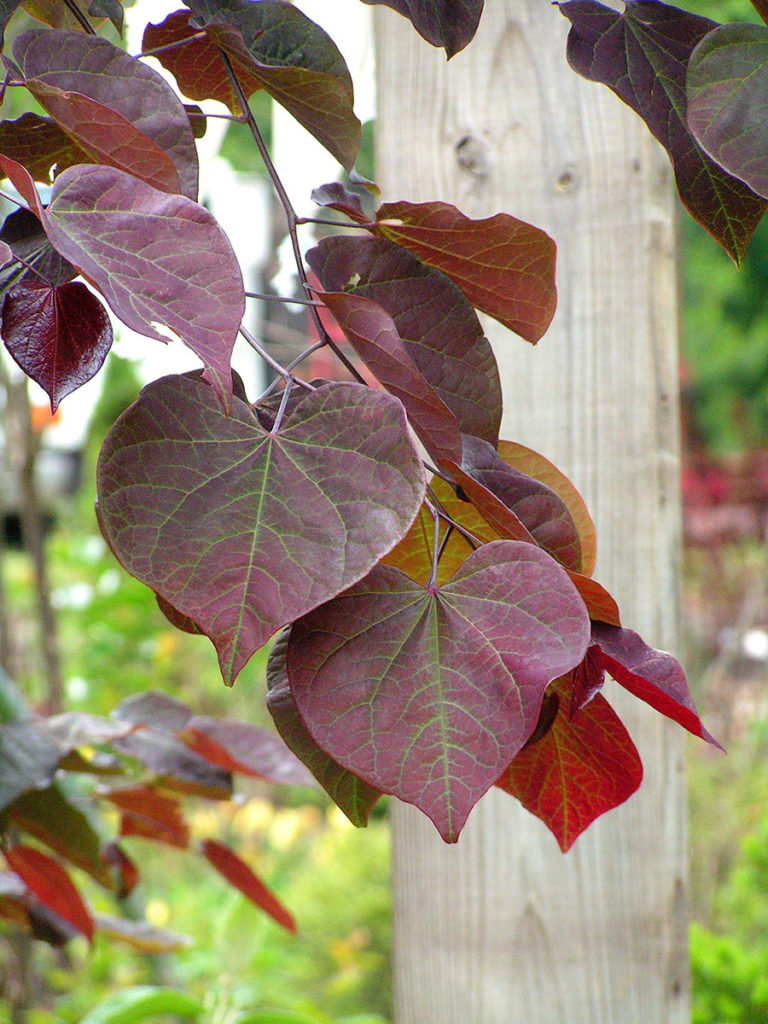
I love my Forest Pansy Redbud (pictured above) but it only survives because it’s tucked in beside the hedge to help break the cold west wind.
Plant the right trees appropriate for YOU
OK, it’s going to get personal now. Only you know your goals. Are you looking for:
- Shade?
- Flowers? and if so, at what time of year?
- Fall foliage?
- Screening?
- Fruit?
- Wildlife habitat?
Always start with your goals for the tree …BEFORE you go shopping. In fact, don’t go “looking” until you’ve done some research. The worst tree choice is likely the one you’d buy on impulse because it was in bloom at the garden centre that day. Remind yourself this is a long-term decision and you want to do it right.
Native Trees are a great place to start
Why not start by looking at native tree choices? The Ontario Tree Atlas is an excellent resource to find what’s native to your region of Ontario. Native trees are generally recommended as some of the best trees to plant. They’ve evolved in our region along with the birds, bees, butterflies, etc that rely on them as food, shelter, or habitat. They tend to be wise investments that are lower maintenance and more hardy for our region.
Here’s an excellent summary of native choices with ratings, soil and light preferences, and mature sizes for Native Southern-Ontario Trees. It’s a summary you can print that is well-researched and documented by Travis Cranmer. His online version is even better and includes good images. (Note – mature size is shown in metres but with the online version, just mouse over the size and you’ll see it in feet).
Spotlight on Carolinian Tree Species – Carolinian Canada is a region in Ontario found south of an imaginary line that runs approximately from Grand Bend to Toronto. The Carolinian life zone is actually the northernmost edge of the deciduous forest region in eastern North America and is named after the Carolina states.

The Carolinian deciduous forests include many common species such as sugar maple, beech, oak, basswood, and ash. They also include several rare and uncommon species of trees and shrubs such as those in this list from Carolinian Canada. A similar list on Ontario.ca offers more insight into the relative rarity of each species.
There are so many good choices! Let’s look at some favourites
Plant the right trees – Top suggestions for small to medium trees
These trees are typically available in the region. All are adaptable enough to be ‘climate-smart’, and all have pros and cons for your urban landscape. Use your personal goals and your site considerations to choose from these options. I’ve only included my best-rated, reliable choices for zones 5-7. Note – Urban lots are best suited to small to medium deciduous or evergreen trees with a mature height of 4 to 10m (12 to 30 ft).
Acer griseum, ‘Paperbark Maple’ – this is a reliable small (7m, 5 ft) tree that handles dry, lean soil and is usually pest free. Grow it for the exfoliating bark and autumn colour in either multi-stem or single stem form.
Acer palmatum, Japanese Maple – so many choices in shrub form or as a small tree – upright or weeping, tall and broad or short and tiered. Leaves also vary but most are dainty delicate purple or green that will turn red, orange, or yellow in the fall. Do your research as not all are hardy to zone 5. Monrovia offers this guidance about varieties.
Amelanchier, Serviceberry – Downy Serviceberry is an excellent native choice. Easily grown in average, medium, well-drained soil in full sun to part shade. Tolerant of a somewhat wide range of soils, but prefers moist, well-drained loams. The branches are covered with white blossoms in spring producing small, showy purple-black, sweet edible fruit (much loved by me if I can get them before the robins). Good fall colour. Size: 6 m high by 4 m wide (20 feet high x 16 feet wide. Two cultivars to consider: Amelanchier laevis ‘Cumulus’, Allegheny Serviceberry and Amelanchier grandiflora ‘Autumn Brilliance’ – hybrid cross between North American species, A. arborea (downy serviceberry) and A. laevis (Allegheny serviceberry), known for its brilliant orange-red fall colour.
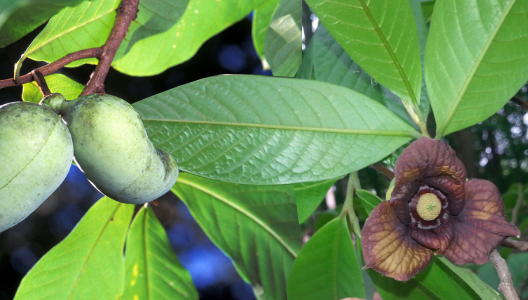 Asimina triloba, Paw Paw – Carolinian – This relatively rare 4-6 metre (12-20 ft) native tree produces one of the tastiest fruits on the planet, with hints of mango, banana, and custard. It has a somewhat ‘ugly-duckling’ droopy form and you’ll need two as it requires cross-pollination. A host for Zebra swallowtail butterflies!
Asimina triloba, Paw Paw – Carolinian – This relatively rare 4-6 metre (12-20 ft) native tree produces one of the tastiest fruits on the planet, with hints of mango, banana, and custard. It has a somewhat ‘ugly-duckling’ droopy form and you’ll need two as it requires cross-pollination. A host for Zebra swallowtail butterflies!
Carpinus caroliniana, aka Blue Beech or American hornbeam – An attractively shaped, low-maintenance understory tree for shady sites. Mature size 6 -8 m (20-26 ft)
Cercis canadensis, Eastern Redbud – a medium-sized tree with lovely tiny rosy-purple flowers along all stems in the spring. Distinctive heart-shaped leaves and a broad form. One cultivar, Forest Pansy Eastern Redbud has purple heart-shaped leaves all season.
Chionanthus virginicus Fringe tree – I love this small tree. The upright branches have magnificent clusters of fragrant, white, fringe-like blooms in late spring. A terrific accent plant in my front yard.
Cornus alternifolia, Pagoda Dogwood – is a small understory native tree with white flowers in June and a lateral branching habit. There’s also a cultivar with variegated foliage Cornus alternifolia ‘Argentea’
Cornus florida, Flowering Dogwood – Carolinian – The flowering dogwood can either take the form of an erect shrub around 3 or 4 metres (13 ft) in height, or a small tree up to 9 metres (30 ft) in height. The tiered branches are covered with large white bracts in spring.
Crataegus phaenopyrum, Hawthorn – This is beautiful when in bloom. Yes, there are thorns but there are so many beautiful aspects of this tree. I love its compact size and showy fruit that gives colour throughout the winter.
Crataegus viridis ‘Winter King’, Hawthorn – is a popular, more disease-resistant cultivar that is noted for lots of flowers, larger fruits, silvery-barked stems, and a purplish-scarlet fall colour (purple and scarlet). It is one of the best hawthorns for landscape purposes. Unlike most hawthorns, this cultivar and species) has only occasional small thorns.
Halesia monticola, Silverbell or snowdrop tree – This tree has attractive white, bell-like flowers that hang down from the branches. It can be a focal point or a backdrop in the garden however it must be planted in a sheltered location with protection from winter winds. Leaves are yellow in the fall.
Magnolia stellata ‘Royal Star’ – a compact-sized tree that is covered with white flowers in early spring. It flowers best in full sun. Ideally site it where protected from high winds, and southern exposures that may entice buds to open too early. This variety blooms about 2 weeks later than the species and is less susceptible to frost.
Picea abies ‘Aurea Magnifica’ , Golden Norway Spruce – OK, full disclosure, my sister has one of these and I am so jealous. This is a stunning evergreen for a front yard. The different shades of yellow add impressive colour throughout the season. Great form and texture. One of the most beautiful spruce cultivars available today.
Pinus aristata – Bristlecone Pine – This is an exceptionally long-living evergreen tree that is native to areas of North America. Grow it because you like its interesting appearance, slow growth, and drought tolerance. It prefers full sun and well-drained soil. Size: 15 feet high and six feet wide.
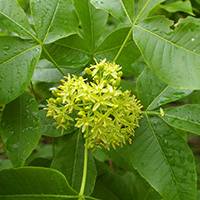
Ptelea trifoliata Common hoptree – Carolinian. I see this rare tree whenever I hike the Morton Trail at Pinehurst Conservation Area. It’s a small tree with smooth reddish-brown bark and alternate, three-parted compound leaves. The cream-coloured, fragrant flowers bloom in early summer. Common Hoptree is found along shorelines in sandy soils, or on thin soils overlying limestone. It does best in full sun and is intolerant of shade. This threatened species is worth considering.
Stewartia pseudocamellia Japanese Stewartia – stunning bark that exfoliates in strips of gray, orange, and reddish brown. The serrated foliage emerges bronzy purple in spring, develops into a dark green by summer, and turns red or orange in the fall. In midsummer, this tree also has “glamorous” white camellia-like flowers! Grows slowly but can reach 10 – 12m (30-40 ft)
Sassafras albidum, Sassafras – Carolinian – Classified as either a tall shrub or small tree, the Sassafras is known for its unique leaf that looks like a mitten, with a thumb on one side. This species has a distinct spicy fragrance that is emitted from the leaves, branches, and bark when crushed. The sassafras prefers rich, sandy loam soil and due to its shade tolerance can be found growing beneath other hardwood trees in the Carolinian zone.
Syringa reticulata ‘Ivory Silk- Tree Lilac – This is a non-suckering variety of lilac with a compact, oval shape that offers unique interest. This has beautiful creamy-white fragrant blooms on stems above dark green foliage in early July. Its yellow fall foliage and textured bark add seasonal interest. It does best in full sun. Size: 20 feet high and 16 feet wide.
Sorbus decora – Showy Mountain Ash – This is a slow-growing, compact, round tree with white bloom clusters in spring and red ornamental berries in fall – great for attracting birds. It requires well-drained soil and prefers full sun. Size: 20 feet high and 16 feet wide.
Other Ideas:
Tight for space? Try Columnar cultivars – If you are concerned about fitting it into a tight space consider a dwarf fastigiate – these cultivars have a pyramidal or columnar form. Check with local nurseries to find pyramidal forms of birch, cypress, hornbeam, oak, sweetgum, and more! Here’s an article about Narrow Trees for Small Gardens from Savvy Gardens
Fruit trees – It’s worth considering growing something to eat!
- So many places to buy – Fruit tree and nut nurseries in Ontario.
- Consider a fruit species grafted on a rootstock to constrain its height.
- Do your research as to whether more than one is required for pollination to occur. Check out Buying, Choice of Cultivars, and Pollination in this excellent guide from OMAFRA – Fruit Trees in the Home Garden
Large trees – not suitable for most urban lots
If you have space, these are my top choices for the largest trees that mature at 20-30 m (80-100 feet):
- American beech
- Butternut – Carolinian indicator species
- Chestnut – Carolinian
- Black maple
- Red maple
- Bur oak
- White oak – Carolinian
- Red pine
- Eastern white pine
And these are my favourite large deciduous trees 10 – 30 m ( 30 to 100 feet) to grow in the Carolinian zone,
 Kentucky coffee tree (Gymnocladus dioica) – The Kentucky Coffee-tree grows 15 to 25 metres (50-80 feet) high. The leaves are as big as 60 by 90 cms (24-35 inches), the largest leaves of any Canadian tree. They are twice compound, divided into many, small bluish-green leaflets. The fruit is a hard, dark, leathery, bean-like pod. This is a threatened tree to be planted and preserved where it can remain forever.
Kentucky coffee tree (Gymnocladus dioica) – The Kentucky Coffee-tree grows 15 to 25 metres (50-80 feet) high. The leaves are as big as 60 by 90 cms (24-35 inches), the largest leaves of any Canadian tree. They are twice compound, divided into many, small bluish-green leaflets. The fruit is a hard, dark, leathery, bean-like pod. This is a threatened tree to be planted and preserved where it can remain forever.
 Shagbark hickory (Carya ovata) – Shagbark is named for its bark which separates into long strips and loosens from the trunk, giving the tree a ‘shaggy’ look. It’s a large 25metre (80 foot) tree that can live for 200 years! Hickory nuts are edible and are a favourite food of squirrels.
Shagbark hickory (Carya ovata) – Shagbark is named for its bark which separates into long strips and loosens from the trunk, giving the tree a ‘shaggy’ look. It’s a large 25metre (80 foot) tree that can live for 200 years! Hickory nuts are edible and are a favourite food of squirrels.
Tulip-tree (Liriodendron tulipifera) – The tulip tree is one of two wild magnolia species found in Canada, and probably one of the most common `Carolinian Canada’ symbols. This is eastern North America’s tallest hardwood, commonly reaching 23 metres (75 feet) in height. It has a tall, straight trunk, a large crown, a distinctive four-lobed leaf, and large green and orange cup-shaped flowers.
Sycamore Platanus occidentalis – This is a very large tree unsuitable for most urban lots. The unusual bark is very distinctive with light-coloured smooth areas, highlighted with patches of darker, reddish, or brown papery bark. The leaves are somewhat like maple, but larger and with less noticeable indentations. The fruit is an unusual ball about one inch in diameter, easy to recognize during the winter.
Print or Download PDF Summary – Plant the right trees! Best choices
So that wraps up my favourites and now it’s time to consider how to ensure our carefully chosen trees survive!
Protect your investment – Plant your tree properly!
Do some research to learn the best ways to plant. I’ve learned a different (much better) method after losing several mature beautiful trees!
Tangled, circling roots MUST be corrected at the time of planting or they will choke the tree causing premature death. Burlap and wire baskets MUST be removed. Potted trees must be root-washed to spread the roots and allow them to develop laterally. Also check for root flare and plant at the correct depth, NOT deeper. Many nurseries pot them too deeply, encouraging superficial surface roots to develop. Why and How to Wash Roots – Linda Chalker Scott
Basic Planting Tips:
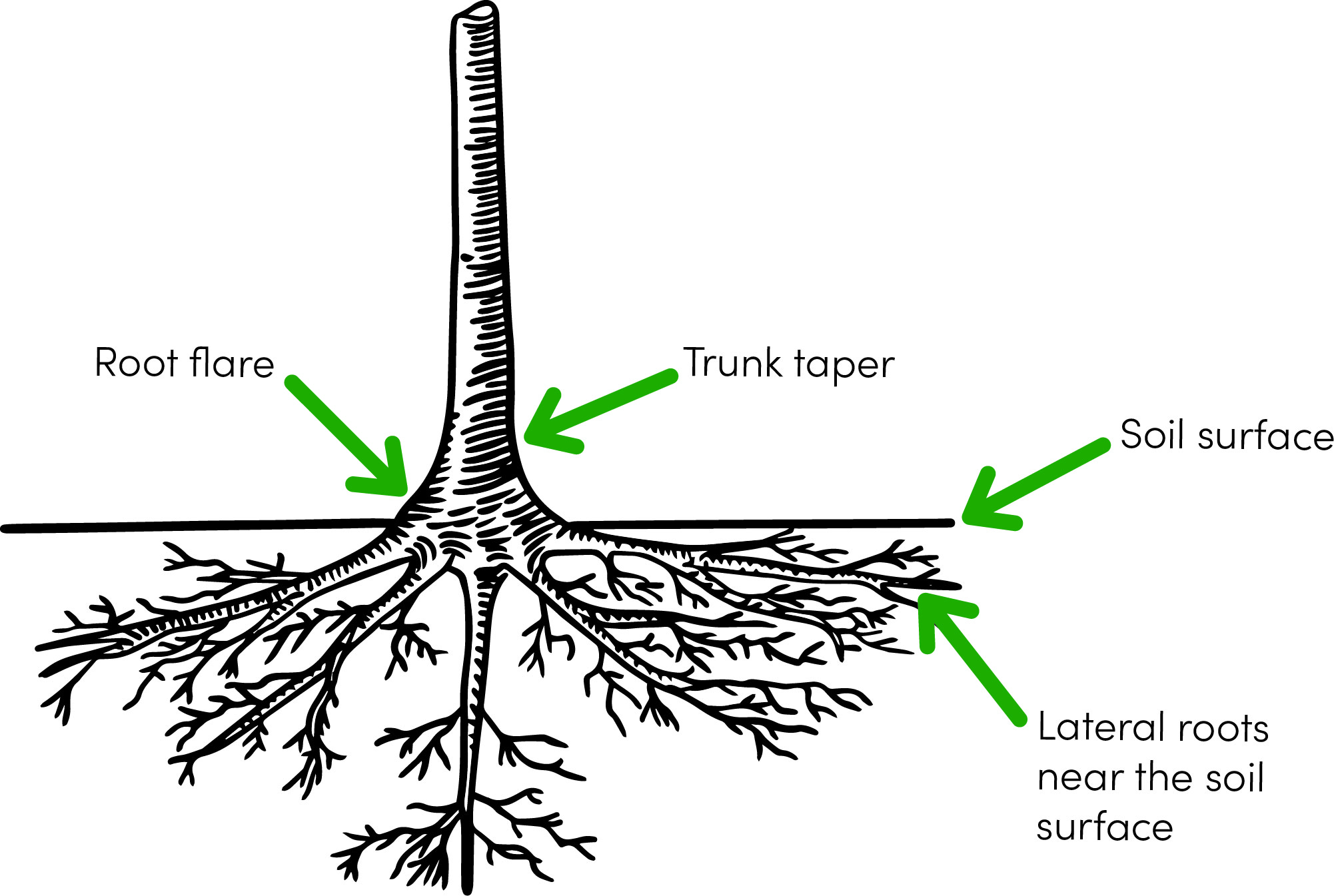
- Root wash to loosen roots and spread them laterally, removing the potted growing medium
- Dig a hole two to three times wider than the container or root ball. The hole should be relatively shallow.
- Plant at the root flare, not deeper
- Only use native soil to backfill (the same soil you removed from the holel. Don’t amend. You want the tree to spread its roots.
- Mulch around the tree with 10-15 cms (4-6 inches) of wood chips (but don’t pile them against the trunk).
- Water well until established – watering deeply once a week when there’s minimal rain. Do this for 1-2 years.
- Generally do not stake, but if you feel it’s necessary, do it properly with two stakes and soft ties.
- Don’t cut back or prune until it’s established. Also don’t fertilize.
When to Plant – Deciduous trees can be planted in the spring, as soon as the frost is out of the ground, or in the fall, from leaf-fall until freeze-up. Conifers can be planted early in the spring until four weeks after deciduous trees have opened their leaves, or in the fall, from about the first week of August to the end of October.
Landscape Ontario Tree Planting Guide 2019 – Here’s a very detailed and comprehensive guide to understanding site considerations, aspects of selection, and proper planting techniques.
More Resources
Worst Threats to Southwest Ontario trees
Forest Health Ontario – tree pests and diseases
Ontario’s Invading species- Forest Pests & Pathogens
Tree Species at Risk – StClair Region
Extensive Field Guide to Tree Diseases Ontario
Tamarack trees are my favourite. Native too!
Buying a Fruit Tree – a little research will pay off!


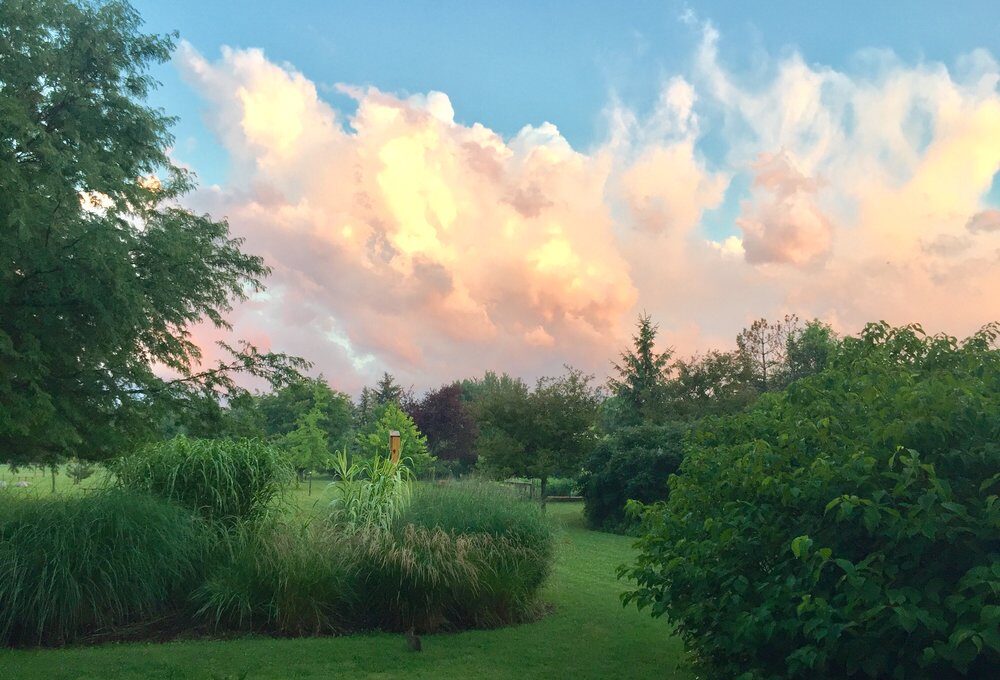


About The Author: Armstrong
As an author and editor, Linda directs her lifelong love of nature and plants to concerns about our environment and how we can do better. In addition to decades of gardening experience, and training as a master gardener, Linda focuses on learning from leading science-based educators and writers, and in the process finds that she uncovers many gardening myths.
More posts by Armstrong